Cudjoe Deep Injection Well Funded But Shallow Well Battle Continues
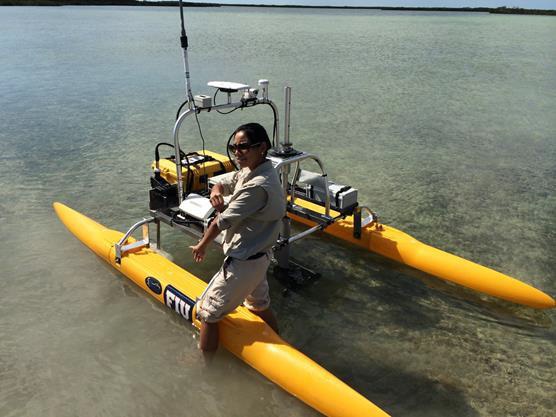
by JD Adler…
March 5, 2015: A team of environmental scientists led by Dr. Briceno of the Florida International University have gathered under blue skies on Cudjoe Key. Their mission: to determine whether the shallow injection wells installed for use in the Cudjoe regional wastewater treatment plant will successfully contain wastewater or whether the ground will prove too porous allowing partially treated sewage to migrate to nearby national marine sanctuary surface waters.
By March 19th they would have already found the answer, as described in the report released April 11.
“We conclude that there are convincing evidences that injected freshwater at the current injection depth of 80’ to 120’, and at the experimental injection rate of 420 gal/min, readily migrates upward and then laterally to the unconfined shallow aquifer and eventually to surface waters. These results are similar to those found by other researchers elsewhere in the Florida Keys.”
~ Design and Implementation of Dye-tracer Injection Test, Cudjoe Key, Florida Keys, Final Report
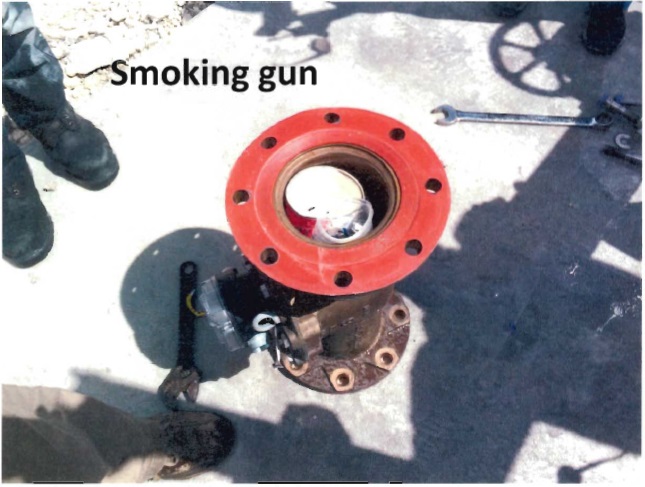
First, they inject regular tap water, to flush the site and prepare for the test. Unfortunately the injection valve is blocked by garbage and the water surges back out like a fountain, creating a puddle alongside the site.
They remove the trash and begin again. First the flush, then dye is injected so that the path of the flow can be traced. Then large quantities of fresh water are injected to simulate wastewater and drive the dye through the system. Four offshore sites (W1-W4) are monitored over several weeks to see if the dye will appear.
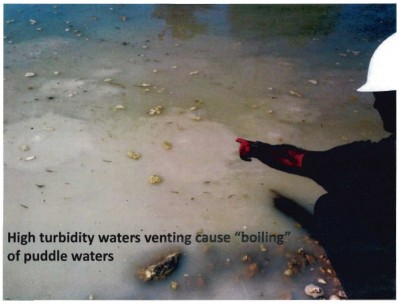
click to enlarge
At first everything seems normal. Then the adjacent, “accidental” puddle begins to bubble. First just a few bubbles, then more and more. Once the air is depleted and water pushes through, mud begins to rise to the surface; signs that the injected water is finding a connection below the surface and forcing out trapped air. If not for the blockage that caused the unintended backflow that created the puddle, might this connection have gone unnoticed?
Time passes and small amounts of dye begin to show in the nearest surface waters being tested, W1 (66 ft.) and W4 (163 ft.). These are referred to as “anomalous readings” because they differ from the pre-test, baseline readings, but they show only minor levels at this point because the fresh water, floating atop the higher density saline ocean water at a rate of 3-11 ft per hour, is quickly pushing the dye beyond the closest sites. More distant sites will have much higher readings that will continue to increase as the test progresses.
The estimated underground flow velocities reach signficantly high values (up to 23 meters per hour or about 75 ft per hour).
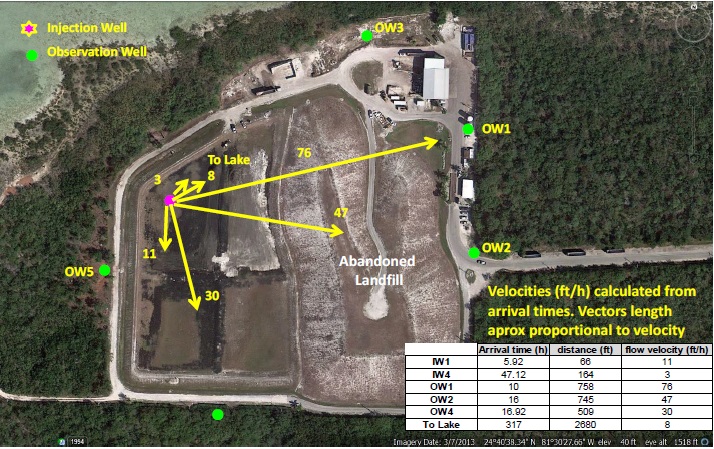
The presence of these anomalous readings suggests that the rock layer, mostly limestone, between the aquifer and the surface waters, has been affected by karsting; a type of erosion affecting carbonated rock, caused by rainwater and other influences, that creates dissolution (i.e. sinkholes, caves, etc) of the material so that it becomes porous.
In the course of preparing this test and the report, satellite images, logged data, and other reports were compiled by Dr. Briceno to create a first attempt at a conceptual model of the subsurface area below the Cudjoe Key treatment plant. As the model shows there is a great deal of karsting beneath the surface.
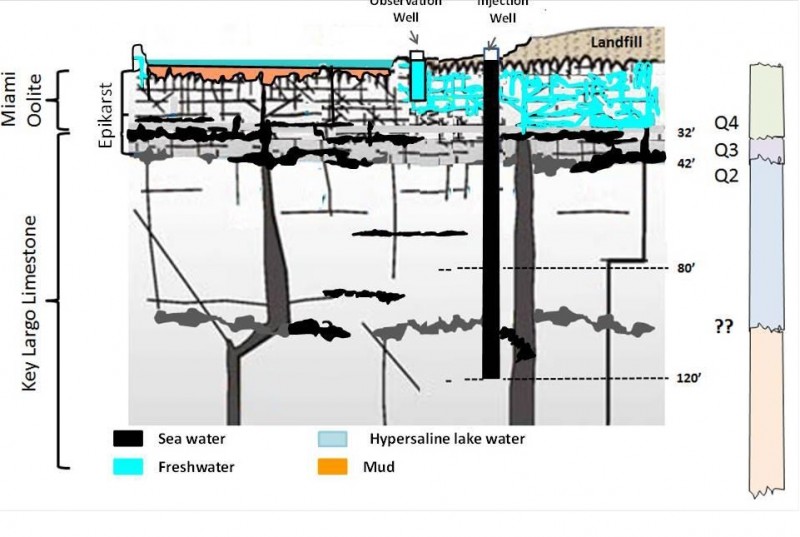
March 19th: Dr. Briceno informs the FKAA of his preliminary findings, at which point FKAA schedules an end to the test, on March 26th, and recommends that Monroe County authorize funding for a deep injection well.
April 11: the final report is submitted to FKAA detailing the results of the test: there is a connection between the shallow injection wells and surface waters in the area. Briceno recommends implementing a deep injection well in order to protect the local environment. This was welcome news to the plethora of community activists and organizations that had been fighting for exactly that, for well over a year.
On April 14, Monroe County Commissioners vote unanimously to approve an additional $7.1 million in funding for the project to uproarious applause from attending community members. FKAA Director Kirk Zuelch signals that this would be added to funding already on hand for the project. Two contractors, which he left unnamed for now, are expected to place bids once the process opens.
Conclusions [from the final report]:
“The Dye-tracer Injection Test described and documented above had one specific objective …’to either confirm or rule-out the existence of hydraulic connection between the shallow injection wells discharge and surface waters.’ We think that objective was achieved by documenting evidences that injected freshwater at the current injection depth of 80’ to 120’, and at the experimental rate of about 420 gal/min, will readily migrate upward and then laterally to the unconfined shallow aquifer and eventually to surface waters.
Two lines of evidence, support this conclusion, first is the physical evidence derived from the Freshwater Injection Test with the appearance of massive bubbling of displaced air coming from underground once injection began. These air bubbles are thought to be driven by ascending injected freshwater. But the most compelling evidence of connection was the venting of muddy freshwater from the bottom of a puddle next to the injection well. Those venting springs were necessarily connected to a high hydraulic head, above ground level, and disconnected to tidal fluctuations at the time of occurrence.
The second line of evidence comes from physical-chemical information, the appearance of dye at concentrations which were statistically anomalous following dye-injection. The estimated underground flow velocities reached very high values (up to 23 meters per hour or about 75 ft per hour), indicating the existence of a system controlled by large solution features and not inter-grain porosity. Results are similar to those found by other researchers elsewhere in the Florida Keys.” [emphasis added]
The Shallow Wells
Still, that is not the end of the story. According to Zuelch, FKAA intends to continue with its planned use of shallow wells during the interim period while the deep injection well is being permitted and installed. Zuelch stated that he will move forward unless told otherwise, “I will follow the lead of the DEP.”
Attorneys Caron Balkany and Christopher Byrd are continuing to pursue a lawsuit against federal agencies under the Endangered Species Act and the National Environmental Policy Act [NEPA] on behalf of local fisherman Mike Laudicinia as well as an Administrative challenge of the DEP’s permit allowing FKAA to utilize shallow well injection at the Cudjoe plant.
Dump the Pumps, a local group opposed to the installation of low-pressure grinder pumps on private lands and the use of shallow well injection, has also announced their intent to file a suit. Both allege that there has been a failure to conduct proper studies regarding the environmental impacts of these shallow wells and that the FKAA has used “fake” documents in order to bypass that requirement.
FKAA insists it had done its due diligence and the document in question is not “fake”, just misunderstood. FKAA Director Zuelch argues that the presence of the word “draft” on the cover sheet should have informed any reader it was not official. Zuelch also stands by the position that use of the shallow wells, while now clearly not the best longterm solution, would still be far better for the environment than relying upon the cesspits and septic tanks currently in use for the next two years:
“This system removes 97-98% of the nitrates, it can be used to water the grass, wash your car, boats. It’s not even comparable to the untreated waste… It’s counterproductive not to treat… environmentally – it makes extremely good sense. The suggestion that the cesspits are a better idea is total, absolute nonsense.”
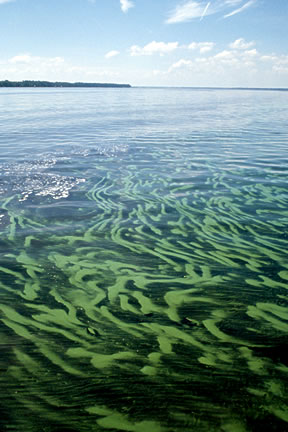
While it’s true that the plant will treat the water to an Advanced Wastewater Treatment (AWT) level, which is approved for uses such as irrigation, critics argue the injection system is not necessarily better than the on site systems currently spread throughout the area. They argue that by gathering wastewater from thousands of homes, treating it, and then injecting the combined partially treated, chlorinated sewage into four shallow wells, the negative impacts to the Cudjoe plant area will be greatly increased due to the resulting concentration of over a million gallons a day of partially treated effluent into one single area. They also question whether or not injecting the water into shallow wells will cause increased leaching of toxic pollutants found in the abandoned landfill that lies adjacent to the plant.
What the recent dye test proves is that the wastewater will escape and reach the groundwater and eventually the ocean. Florida law allows AWT to contain 10 times the nitrogen and 100 times the phosphorous considered acceptable for near-shore waters. This same law states that, “Except as provided in subparagraph 3. for backup wells, if the design capacity of the facility is equal to or greater than 1 million gallons per day, each primary injection well must be cased to a minimum depth of 2,000 feet or to such greater depth as may be required by department rule.” According to shallow well opponents, the CRW is expected to far exceed the 1 million gallon per day benchmark and shallow wells should never have been an option.
So, while cesspits and septic tanks are clearly not optimal, the question remains as to whether use of a shallow well system in the interim is even lawful. The answer lies, at least in part, in an environmental impact study that, according to US Fish and Wildlife Service, is required by federal law, but has never been done.
Adding to the confusion is a series of actions taken by the FKAA over the years which have raised accusations of dishonesty.
- In 2009 the requirement to publish notices regarding permits to do public works, in this case the Cudjoe treatment plant, in newspapers in the vicinity of the proposed project was bypassed by FKAA when it instead published the notice in a newspaper in Broward County.
- In 2010 a draft environmental assessment was sent to the Army Corps of Engineers as part of a request for additional federal funding that essentially asked the Corps to perform an environmental impact study and sign off on the proposed assessment. Since no more funding was available, no study was conducted and the document was never even examined by the Corps. Yet the document appeared, subsequently, attached to other proposals with the Corps logo on it, including the final plan for the CRW and a request for DEP RESTORE Act funding that specifically referred to the document as “an Army Corps prepared draft.” Additionally, it appears the data in the 2010 “draft EA” was taken from a 2006 document the Army Corps did prepare for the South Florida Water Management District, as part of a larger, Keyswide assessment that did not include the Cudjoe plant.
- In 2013 a letter was sent to Fish and Wildlife (FWS) by DEP requesting an environmental impact study. FWS did not respond, so rather than follow up and ensure the environment would be protected, government employees simply chose to interpret the lack of response as a go-ahead. A concept which has been refuted in a recent letter from the FWS to the EPA.
- FKAA has consistently stated there was no federal funding involved, although it was confirmed by the DEP, on March 21, 2015, and by USFWS on April 9, 2015 that Monroe County did use federal funds for the CRW which were obtained from the Florida State Revolving Loan Fund.
Current Status
At this point, Monroe County has approved funding for a deep injection well, the FKAA intends to continue to move forward with the use of shallow wells as an interim system, two federal lawsuits are pending designed to prevent the use of the shallow wells until a federal environmental impact study can be done and the US Fish and Wildlife Service has sent a letter to the EPA recommending they look into assessing the environmental impact of the CRW, crediting community action for bringing it to their attention.
DID YOU LIKE THIS STORY? SUPPORT THE BLUE PAPER
Help us continue to bring you local investigative journalism… Click on the image to make a donation [NOT tax deductible].




JD,Dump the Pumps opposed, and opposes, the use of grinder pumps, not gravity pumps. I never heard of a gravity pump. Dump the Pumps wants gravity sewerage collection used wherever feasible. The Monroe County Commission wanted grinder pumps used wherever possible, because they are cheaper to install than gravity systems. That got chipped away on the Sugarloaf Keys and on Cudjoe Key, by people like Walter Drabinsky and Todd German. Their areas ended up mostly with gravity, and grinder pumps only where gravity was not feasible.Summerland Key up through Big Pine Key was predominantly slated for grinder pumps. That’s what birthed Dump the Pumps, grinder pumps. I know this, because I was taking with them all along and attending their meetings on Little Torch and Big Pine Keys.
Early on, news of a New Jersey grinder pump disaster was common knowledge in the Dump the Pumps camp. Hurricane Sandy knocked out the electricity in a subdivision using grinder pumps, which rely on electricity to work, and Sandy also flooded the subdivision. Human waste was in the yards and backed up in the homes, and Hazmat workers had to be sent in to clean it up. Back in the fall of 2005, Hurricane Wilma knocked out the electricity in the lower keys and flooded the lower keys with sea water, like what happened to the lower lying areas of Key West. Dump the Pumps contended that another Hurricane Wilma would produce the same grinder pump failure and disaster in the lower Keys, that Hurricane Sandy produced in the New Jersey subdivision.
The Sandy-Wilma comparison was made many times to the Monroe County Commissioners and to FKAA officials, and was dismissed by them. Other serious problems with grinder pumps were presented to those officials, and were dismissed.
I participated in a string of emails, mostly as an observer, between County Commissioner George Neugent, in whose voting district Cudjoe Regional lies entirely, and various of his constituents who opposed grinder pumps. George’s attitude in the emails was haughty and arrogant. He dismissed all arguments, as himself being an expert on pumps, dating back to his days in the oil well business, and having had a grinder pump at his restaurant in Marathon. George put down his constituents. He blasted them.
Finally, I emailed George, copied to the entire audience in that email thread. Well, if he and the other county commissioners really believed grinder pumps were as good as, or even better than, and cheaper than gravity collection, then he and the other county commissioners would have had a duty to use grinder pumps, instead of gravity. He and the other county commissioners would have told Walter Drabrinski,Todd German and others that grinder pumps were going in everywhere feasible in the Sugarloaf Keys and on Cudjoe Key, and in the entire Cudjoe Regional Sewer District. George’s reply to me was a bit subdued, including, well, he never said he was an expert in grinder pumps.
I tried very hard to get Naja to go after all of that, and she told me, which she repeated just the other day at her home, that the Dump the Pumps people waited too long; they should have joined Walt Dabrinski and others, when they started fighting Monroe County and FKAA about grinder pumps. So she was not going after it. Naja also said, she let others go after it, in the blue paper, who knew about grinder pumps, which did happen in the blue paper, eventually.
Naja said she’d never heard of the New Jersey grinder pump disaster, until I told her about it the other day. If she had known about that, and it could be proven, she would have gone after it. I went after the New Jersey disaster many times at my websites, and Naja got copies of all of those articles.
All as grinder pumps were being installed, despite many serious arguments being made that grinder pumps should only be used where gravity is not feasible, while FKAA itself was saying it preferred gravity over grinder pumps, and would use gravity everywhere feasible, if the County Commission would pay for it.
Now Dump the Pumps and others are seeking federal court injunctions. This course of action was recommended to Dump the Pumps in the fall of 2013, by a young lawyer, who worked for a federal agency in the Florida Keys. He lived on Little Torch Key. He was slated to get a grinder pump. He could not bring the lawsuit, because he worked for a federal agency. As I recall, he got around to saying he was selling his home, because of how FKAA and the Monroe County Commission were going about using grinder pumps, instead of gravity.
I told Dump the Pumps the young lawyer was right, they should seek federal court relief, and not waste time in state courts and wrangling with the Florida Department of Environmental Protection, which agency was a joke. I told Dump the Pumps they would get no relief going that route, and lobbying the County Commission and FKAA would bring no relief. I told Dump the Pumps they had waited too long already. Get to cracking.
And, I wondered why I had not jumped into that fight, when I lived on Little Torch Key from 2010-August 2013, and was slated to get a grinder pump on my land, for my trailer? I was asleep at the switch, and only after I moved back to Key West that August, was I told in a dream to get to cracking about grinder pumps.
All the while, FKAA is installing grinder pumps, and Dump the Pumps is trying to stop it. As far as I know, Last Stand and the blue paper have not raise a hue and a cry about grinder pumps, but have focused on going with a deep injection well, instead of shallow injection wells. Dump the Pumps joined into that fray, too.
For me, the real danger with shallow injection wells in Cudjoe Regional is the old land fill (toxic waste dump) near where the shallow injection wells were installed. The very real risk of the shallow injection wells getting into and disturbing that landfill and what is buried in it should be sufficient to not use the shallow injection wells at all.
What boggles my mind, what boggles Naja and Arnaud’s minds, what should boggle everyone’s minds, is FKAA and the County Commission and the Florida Department of so-called Environmental Protection, which can be likened to the Florida Department of Law Enforcement, designed and installed shallow injection wells, without first doing a test to see what might happen, if shallow injection wells were used.
What does that tell you about the smarts of your five county commissioners, FKAA and FDEP? Or is something else going on? Is maybe spending as little as possible on Cudjoe Regional, so other things can be bought by the County Commission, going on?
And, is there something under the table going on with grinder pumps? Is somebody getting payola, who should not be getting payola?
That’s my story and I’m sticking to it.
Hey Sloan,
How about a link to that New Jersey disaster article? I had seen an article about one homeowner having a horror story about a faulty valve and sewage backing up and covering the floors of the house. [Eeeww!!] Please send the link to the story you spoke about the other day – where an entire subdivision found themselves swimming in sewage. Thanks!
JD,
As always, superb investigation, brilliant research and extraordinarily written.
Scientific studies and research have concluded that ‘state of the art’ septic tanks, are in many cases, the best and most natural means to treat human waste.
This simple, cost effective and scientifically sound method of treating sewage; has demonstrated its efficacy. Septic tank designs that are appropriately positioned, properly installed and maintained can work in concert with Mother Earth to keep our environment healthy.
EFFIICIENCY OF SEWAGE TREATMENT WITH SEPTIC TANKS FOLLOWED BY CONSTRUCTED WETLANDS WITH DIFFERENT SUPPORT MATERIAL…
ABSTRACT
This study seeks to assess the efficiency of a sewage treatment plant comprised of three compartmentalized septic tanks installed in series followed by three parallel wetlands and seeded with species Typha sp. with subsurface flow, filled with support material of natural gravel, gravel # 2 and washed gravel, respectively. The station treats sewage generated at Unity University for Science and Technology, State University of Goiás – UnUCET/UEG. A total of 20 sewage samples were collected in order to evaluate treatment efficiency from November to December 2010 and March to April 2011. The points of analysis were at the input of the first tank (raw sewage), the output of the third septic tank and the outputs of each of the three wetlands. The total removal efficiencies were: 65.40% for chemical oxygen demand; 79.01% for biochemical oxygen demand; 59.79% for total solids; 87.12% for the total suspended solids; 92.00% for total coliforms; 95.71% for E. coli and 82.54% for turbidity. The system was effective for the treatment of sewage, within the current legislative parameters for pH, turbidity, total solids and biochemical oxygen demand. No significant difference was observed between the three different means of support, suggesting that gravel, natural gravel and washed gravel may potentially be used to fill wetlands.
Revista Ambiente & Água – An Interdisciplinary Journal of Applied Science: v. 8, n.1, 2013.
At long last, have these crooks have no shame or sense of decency? Mr. Zuelch, like the “I trust our engineers” commissioner, should resign or be removed. How sad, too, that so many agency personnel charged with resource protection — from DEP to NOAA to USFWS — for years shirked their duties. There should accountability and hell to pay for this negligence. Thank god that a few brave citizens, against long odds refused to accept an enormously flawed sewer system.
Lots of info here in another town which fought the grinder pumps. I believe they succeeded in getting them removed.
https://sarasotan3sewers.wordpress.com/category/grinder-pumps/page/4
An excerpt:
Rockridge, FL
Rockridge is an unincorporated community of 416 homes in Indian River County, Fl. and is closely associated with the city of Vero Beach. For more than 20 years Rockridge residents relied on low-pressure grinder pumps for their sewer needs. The system apparently worked satisfactorily unless there was a power failure, at which point the grinder pumps were rendered useless. And in 2004 that’s exactly what happened… big time.
Three Major Hurricanes
First Charley hit Punta Gorda. Then came Hurricane Francis and three weeks later, Hurricane Jeanne, both making landfall near Ft. Pierce. Rockridge lost electrical service for two extended periods of time, ten days after Hurricane Francis and 14 days after Jeanne. Without electricity, the community’s low-pressure grinder pump system was shut down. It seems that the residents had to evacuate, because the President of the Rockridge Homeowners Association had this to say: “It was bad. When we came back, everything had to be destroyed, the sheetrock, the furniture, the carpets… we had to spray everything with bleach to kill the bacteria. Rockridge is primarily a retirement community and many of the homeowners are in their eighties, so it was especially difficult for them”.
Low Pressure Sewer System Condemned
When it came time to rebuild, the various agencies that looked at the system of grinder pumps all declared the system condemned. They saw no need to repair a system so susceptible to power loss and prone to environmental nightmares. The decision was made to install a new vacuum sewer system to serve the Rockridge community.
Whoa. Hold the phone.
Great article and thanks for the link to download the Final Report!
But nobody saw the elephant in the room when a deep well was authorized.
This plant is expected to have a peak hour flow of over 4 million gallons per day (mgd).
On high flow days, the average flow for the entire day will be 2.35mgd.
That number was derived based on the ridiculous assumption that 40% of water going through inner island meters will not be returning as wastewater because everyone waters their lawns and foliage so much. (What?! On the pearock yards?! What were the engineers smoking? How will that 40% that is not actually being used for irrigation get through the pipes? How will the plant treat it?)
At the experimental flow rate of only 420gpm, which equals only 0.60 mgd, water is boiling out of the ground adjacent to the wells and carrying tracer dye to the surface everywhere. It is shown flushing the base of unlined trash mountain of its leachate.
DEP regulations require that there be two effluent disposal methods- the primary and a back-up. FKAA was told in a written report by their consulting engineers CH2M Hill back in March 2008 that they would need TWO deep wells- one for normal use, and one for backup- if they consolidated the 3 plants proposed in the 2000 WW Master Plan into one plant.
Now, DEP regulations would normally allow for the backup to be shallow wells, but in this case, shallow wells do not work at even a 0.6mgd rate. So they obviously will not work at four times that rate. DEP warned FKAA management in July 2008 that shallow wells often do not work in the Keys.
Monroe County directed the use of this particular site in an abundance of recklessness, not caution. Now they see that was a really bad idea, like all of the CRWS decisions that they have not admitted yet. The BOCC now needs to reach back in that bag of money and pull out another few million for the backup well. Now, while it all gets done at once for the lowest price.
FKAA management has totally wasted about a half million dollars on shallow wells that must never be used for anything. They have not accounted for where they will drill deep wells or how they will power the big pumps needed for a deep well. The backup generator at the plant site will not handle both the plant and the deep well pumps. Who will be held accountable for ignoring all the warnings of DEP and the consulting engineers? Who will be held accountable for squandering all that money? Who will be held accountable for building an undersized collection system that does not even meet minimum design standards and now has nowhere to go? All of this meets the official definition of “shitstorm”, and someone is responsible.